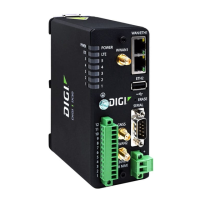Routing IP routing
IX30 User Guide
275
IP routing
The IX30device uses IP routes to decide where to send a packet it receives for a remote network. The
process for deciding on a route to send the packet is as follows:
1. The device examines the destination IP address in the IP packet, and looks through the IP
routing table to find a match for it.
2. If it finds a route for the destination, it forwards the IP packet to the configured IP gateway or
interface.
3. If it cannot find a route for the destination, it uses a default route.
4. If there are two or more routes to a destination, the device uses the route with the longest
mask.
5. If there are two or more routes to a destination with the same mask, the device uses the route
with the lowest metric.
This section contains the following topics:
Configure a static route 276
Delete a static route 279
Policy-based routing 281
Configure a routing policy 282
Example: Dual WAN policy-based routing 290
Example: Domain-based routing with dual WAN 292
Example: Route traffic to a specific WAN interface based on the client MACaddress 295
Routing services 301
Configure routing services 302

